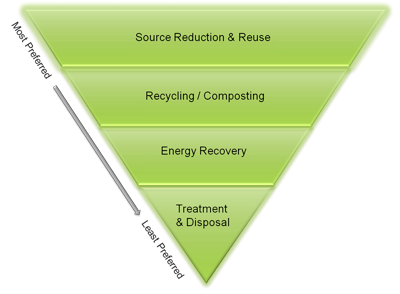Waste Management Hierarchy
 Waste management hierarchy ranks the various management strategies from most to least environmentally preferred. The hierarchy places emphasis on reducing, reusing, and recycling as the keys to sustainable materials management.
Waste management hierarchy ranks the various management strategies from most to least environmentally preferred. The hierarchy places emphasis on reducing, reusing, and recycling as the keys to sustainable materials management.
Waste Reduction and Reuse
Source reduction, also known as waste prevention means reducing waste at the source. It is the most environmentally preferred strategy. It can take many different forms, including reusing or donating items, buying in bulk, reducing packaging, redesigning products, and reducing toxicity. Source reduction also is important in manufacturing. Lightweighting of packaging, reuse, and remanufacturing are all becoming more popular business trends. Purchasing products that incorporate these features supports source reduction.
Benefit of Waste Prevention
• Save natural resources,
• Conserve energy,
• Reduce pollution,
• Reduce toxicity of our waste, and
• Save money for consumers and businesses alike.
Recycling and composting
Recycling is a series of activities that includes collecting used, reused, or unused items that would otherwise be considered waste; sorting and processing the recyclable products into raw materials; and remanufacturing the recycled raw materials into new products. Consumers provide the last link in recycling by purchasing products made from recycled material, composting of food scraps, yard trimmings, and other organic materials is also considered as recycling.
Benefits of Recycling
• Preventing the emission of many greenhouse gases and water pollutants;
• Saving energy;
• Supplying valuable raw materials to industry;
• Creating jobs;
• Stimulating the development of green technologies;
• Conserving resources for our children's future; and
• Reducing the need for new landfills and combustors.
Energy Recovery
Energy recovery from waste is the conversion of non-recyclable waste materials into useable heat, electricity or fuel through variety of processes, including combustion, gasification, pyrolization, anaerobic digestion and landfill gas (LFG) recovery. This process is often called waste-to-energy (WTE). Converting non-recyclable waste materials into electricity and heat generates a renewable energy source and reduces carbon emissions by offsetting the need for energy from fossil sources and reduces methane generation from landfills. After energy is recovered, approximately ten percent of the volume remains as ash, which is generally sent to a landfill.
Treatment and Disposal
Prior to disposal, treatment can help reduce the volume and toxicity of waste. Treatment can be done physically (e.g., shredding), chemically (e.g., incineration) or biologically (e.g., anaerobic digester). Landfill is the most common form of waste disposal. It is an important component of an integrated waste management system.
Sources: https://www.epa.gov

